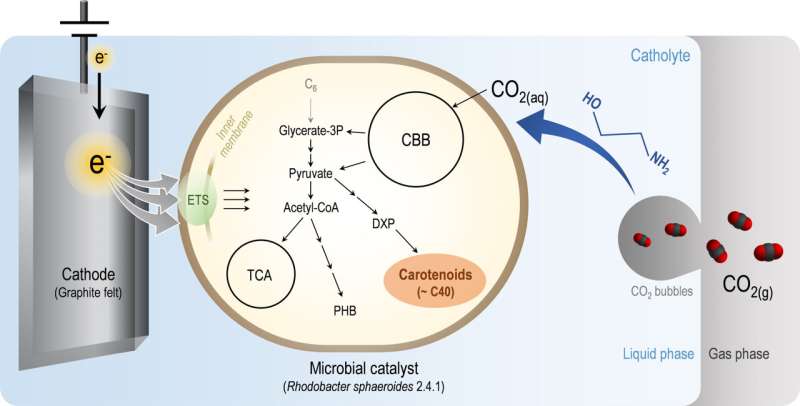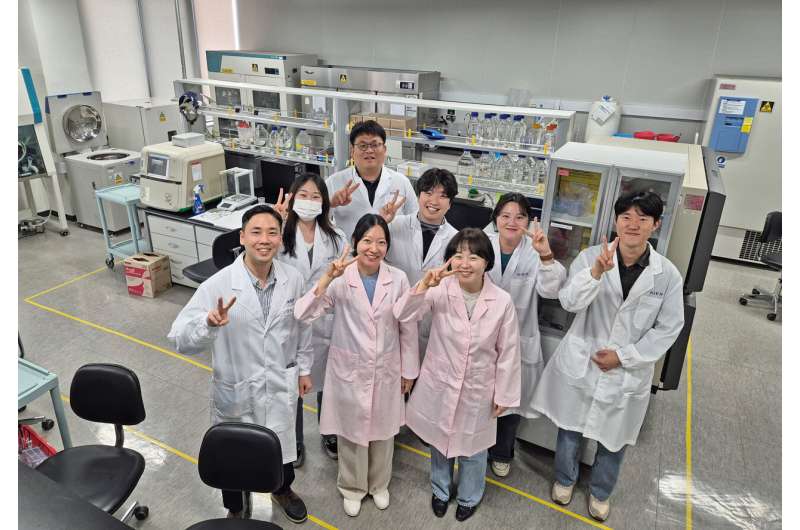This article has been reviewed according to Science X's editorial process and policies. Editors have highlighted the following attributes while ensuring the content's credibility:
fact-checked
trusted source
proofread
Carbon dioxide, the main culprit of global warming, reborn as an antioxidant substance

A research team led by Dr. Lee Soo Youn at the Gwangju Clean Energy Research Center of the Korea Institute of Energy Research (KIER) has successfully converted carbon dioxide, the main culprit of global warming, into carotenoids, which possess antioxidant and anticancer effects. The findings were published in ChemSusChem.
According to the International Energy Agency, global energy-related carbon dioxide emissions reached a record high of 37.4 billion tons in 2023, an increase of 1.1% from the previous year. The country is also facing climate change due to carbon dioxide emissions, as evidenced by experiencing the hottest April on record this year.
To address this issue, carbon dioxide conversion technologies are being developed globally. The technology to convert carbon dioxide into high-value chemicals such as ethylene and propylene is emerging as a key technology for achieving carbon neutrality, as it not only reduces carbon emissions but also produces products that can be utilized in various industries.
Recently, microbial electrosynthesis (MES) technology for producing chemicals has been gaining attention as a promising method for carbon dioxide conversion. MES typically involves creating an electrolyte solution with water containing microorganisms and dissolving carbon dioxide into the electrolyte, which the microorganisms then use as nutrients.
However, in room temperature and normal pressure conditions where microorganisms grow, the amount of carbon dioxide that dissolves in water is very low, leading to a shortage of nutrients for the microorganisms and resulting in low productivity of the final converted substances.
To address this issue, the research team dissolved the carbon dioxide absorbent monoethanolamine (C2H7NO) in the electrolyte to increase the amount of carbon dioxide available for the microorganisms (Rhodobacter sphaeroides). This approach increased the consumption of carbon dioxide by the microorganisms, thereby enhancing their energy production, growth, and metabolic activities, which in turn improved the production efficiency of the converted substances.
The research team also expanded the range of conversion products. While conventional microbial electrosynthesis technology produces substances with low carbon numbers, such as butanol and ethanol, due to low carbon dioxide concentrations, the team's technology can produce carotenoids with higher carbon numbers.

Carotenoids, known for their anti-aging effects on cells and used in cosmetics and supplements, are traditionally produced through microbial fermentation. However, issues with safety and raw material supply have limited production. Additionally, since carotenoids are composed of 40 carbon atoms, microorganisms must consume large amounts of carbon dioxide to produce them.
By using a high concentration of carbon dioxide, the research team improved productivity by about four times compared to existing technologies, enabling the production of carotenoids through microbial electrosynthesis.
Dr. Lee Soo Youn, the senior researcher, stated, "This research presents a new approach to converting carbon dioxide into high-value substances through microbial electrosynthesis. As an eco-friendly and highly potential 'platform chemical' technology in the bioenergy and biochemistry fields, it will contribute to achieving carbon neutrality by reducing and recycling greenhouse gases."
More information: Hui Su Kim et al, Enhancing microbial CO2 electrocatalysis for multicarbon reduction in a wet amine‐based catholyte, ChemSusChem (2024). DOI: 10.1002/cssc.202301342




















